.
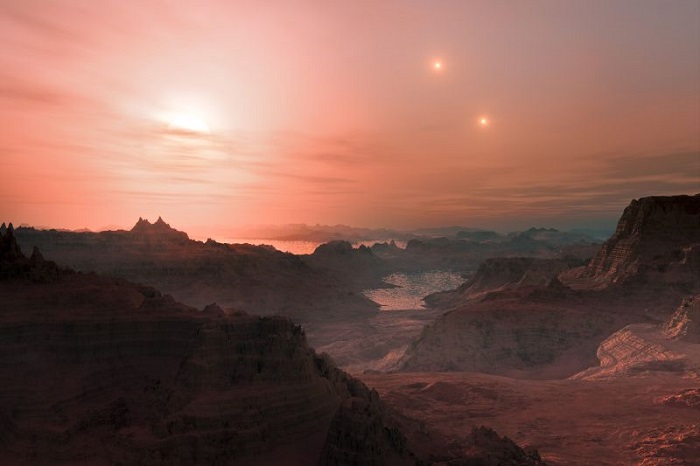
The possibility of life and intelligence appearing very early in the history of the Universe has been pondered in many science fiction stories, from Arthur C. Clarke’s “Odyssey” book series to “Star Trek” and “Babylon 5″ on television. Though speculative, this idea has been given more credence in recent years, with the discovery of many exoplanets around the long-lived red dwarf stars that permeate the galaxy and from a series of studies suggesting that the conditions on at least some of these planets could allow for the emergence and development of life.
Red dwarfs, officially known as M-class stars, are considered to be the most abundant stellar population in the Milky Way galaxy. Astrophysicists have calculated that red dwarfs generally account for approximately 90 percent of the stars inside elliptical galaxies and 70 to 80 percent of those inside spiral galaxies like our own. Cooler, dimmer, and less massive than G-type yellow dwarf stars like the Sun, red dwarfs burn their nuclear fuel at a much slower rate, which allows them to live for hundreds of billions to even trillions of years.
Historically, red dwarfs were generally neglected by astrobiologists in their search for life elsewhere in the Universe. Conventional wisdom held that conditions near these stars would make the emergence of life very unlikely on any planets orbiting around them. With surface temperatures ranging between 2,500 to 4,000 K and luminosities between 1/10,000th to 10 percent that of the Sun, red dwarfs were considered too dim for harboring any habitable planets. Furthermore, the habitable zones around red dwarfs lie very close to these stars. Any possible planets orbiting these stars would probably end up being tidally locked, with one hemisphere constantly facing the star and the other constantly buried in eternal darkness. Red dwarfs themselves are also very active, especially during the first couple billion years of their lives, regularly shooting off large solar flares while bathing their surroundings with large doses of lethal ultraviolet radiation.
.
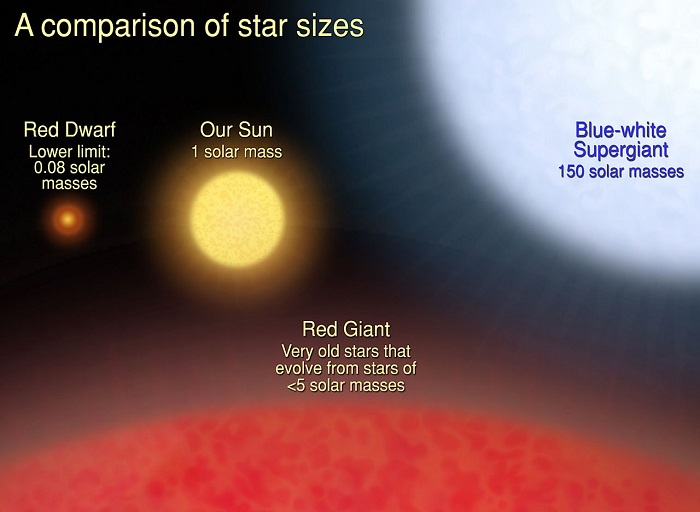
A comparison of different star sizes, shown to scale. Image Credit: NASA, ESA and A. Feild (STScI)
.
Yet studies in recent years have painted a picture showing that red dwarfs could be more hospitable to life than previously thought. For instance, it was argued that any possible habitable “Super Earths” (planets with masses slightly larger than Earth’s) that would possess a strong magnetosphere would brave coronal mass ejections and most of the lethal ultraviolet radiation that these stars emit. In addition, theoretical models have shown that a thick, cloudy atmosphere with a chemical composition consisting of carbon dioxide and water would be able to stabilise the temperatures in both hemispheres of a tidally locked planet, through convection and atmospheric circulation. Such were the results of a study made in 2013 by a team of scientists led by Jun Yang of the University of Chicago’s Dept. of the Geophysical Sciences, concluding that “our results demonstrate that at high stellar flux, Earth-like tidally locked planets have a high planetary albedo, a low greenhouse effect, and therefore low enough surface temperatures to be habitable.”
A new study to be published in Monthly Notices of the Royal Astronomical Society by an international team of astronomers brings red dwarfs again in the spotlight by announcing the discovery of eight new exoplanet candidates orbiting the nearby red dwarf stars GJ 27.1, GJ 160.2, GJ 180, GJ 229, GJ 422, and GJ 682, located between 15 and 80 light-years from Earth.
The team worked with data from past observations of 41 nearby red dwarfs that were conducted with two high-precision “planet-hunting” instruments at the European Southern Observatory (ESO) in Chile: the High Accuracy Radial Velocity Planet Searcher, or HARPS, and the Ultraviolet and Visual Echelle Spectrograph, or UVES, installed on ESO’s 3.6m telescope at the La Silla Observatory and the Very Large Telescope (VLT) on Cerro Paranal respectively. Both spectrographs have been very successful in the search for exoplanets, discovering many dozens of alien worlds that have made headlines in recent years, including possibly habitable ones around Gliese 581 and Gliese 667, two red dwarf stars 20 and 22 light-years away, respectively, and Alpha Centauri Bb, a planetary candidate around Alpha Centauri, the closest star system to the Sun, 4.37 light-years away.
.
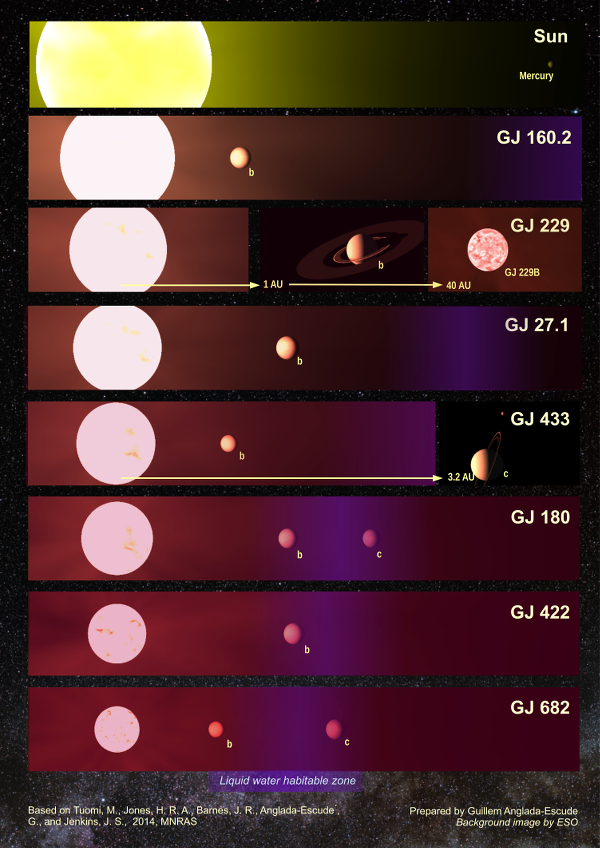
Conceptual art of the new planetary candidates discovered by Tuomi’s team. Image Credit: Guillem Anglada-Escudé, Queen Mary University of London
.
Both instruments hunt for planets using the “radial velocity” method. Where Kepler and other space telescopes look for the dimming of a star’s light caused by the passage of a planet across the star’s face, HARPS and UVES look for the gentle “wobble” in a star’s motion, caused by the gravitational tug of the planets orbiting around it. This wobbling motion is reflected in the star’s spectrum, with specific spectral lines displaying constant, periodic displacements, or Doppler shifts, due to the star’s periodic movement toward and away from us. As an exoplanet detection technique, radial velocity has been the most widely used and is most useful when searching for planets that lie really close to their host stars. This makes it ideal for the discovery of possible habitable planets around red dwarfs as well.
Although both spectrographs separately detected signs for the existence of planetary candidates around the stars examined in the recent study, the signals weren’t clear enough to stand out from the random noise in the data. The team of astronomers used a Bayesian statistical analysis for both the HARPS and UVES data, with which they were able to detect the exoplanet signatures. “We were looking at the data from UVES alone, and noticed some variability that could not be explained by random noise,” says Mikko Tuomi an astronomer at the University of Hertfordshire, U.K., and lead author of the study. “By combining those with data from HARPS, we managed to spot this spectacular haul of planet candidates.”
.
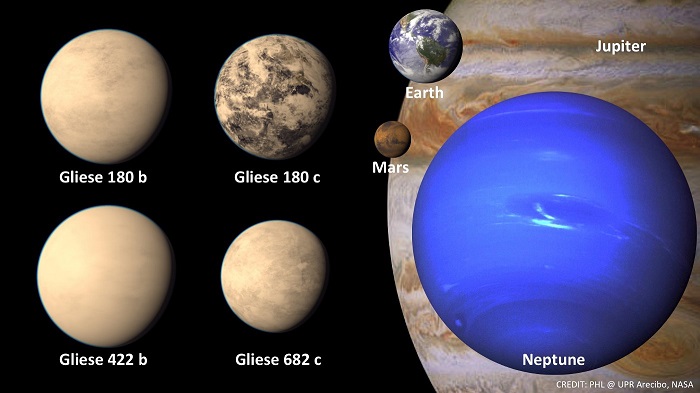
Artistic representation of the habitable zone Super-Earth planets Gliese 180 b and c, and Gliese 422 b, and Gliese 682 c. Earth, Mars, Neptune, and Jupiter are shown for size comparison. Image Credit/Caption: Planetary Habitability Laboratory @ UPR Arecibo, NASA.
.
The most interesting part of Tuomi’s team’s exoplanet discoveries was that most of the planet candidates were found to be “Super Earths,” with masses ranging from 4.5 to 10 times that of our planet. “Based on the analyses of the combined UVES and HARPS radial velocities of the 41 nearby M dwarfs,” writes the team in their study, “these data sets contain the signals of eight new exoplanet candidates, out of which seven can be classified as Super Earths due to their minimum masses that are higher than that of the Earth, but still lower for most candidates considerably so, than one Neptune-mass.” In addition, four of the newly discovered planets, Gliese 180b and c, Gliese 422b, and Gliese 682c, lie inside the habitable zone of their respective stars.
Based on the sample of the eight newly discovered candidates, and the presence of ten more additional planetary-like signals that couldn’t be separated from the noise in the data to be confirmed as candidates, Tuomi’s team used the same Bayesian statistical analysis method to estimate the probability and overall occurrence rate of planets around red dwarf stars in the Sun’s cosmic neighborhood. To that end, they divided planets in two plots: one for orbital periods ranging between 1 and 10,000 days, and one for mass, ranging between 3 and 100 Earth masses. The team used their statistical analysis methods to try and see the probability of occurrence for the planets in each subdivision.
The team’s results showed that every red dwarf must harbor at least one Super Earth-sized planet and that nearly 25 percent of all red dwarfs examined should harbor a habitable planet. “The resulting occurrence rates show several features that can be considered as representative of the underlying population of planets around M dwarfs,” writes the team in their study. “According to our results, M dwarfs are hosts to an abundance of low-mass planets and the occurrence rate of planets less massive than 10 Earth masses, is of the order of one planet per star, possibly even greater. Our results also indicate that planets with masses between 3 and 10 Earth masses, are common in the stellar habitable zones of M dwarfs, with an estimated occurrence rate of 0.21 planets per star.”
.
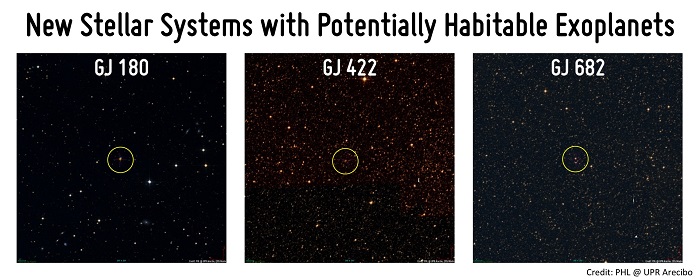
These images show the star fields around the new three stellar systems with four potentially habitable planet candidates discovered by astronomers led by Mikko Tuomi from the University of Hertfordshire. The field of view is about the size of the full Moon. A small telescope is necessary to see these since they are dim red dwarf stars. Image Credit/Caption: Planetary Habitability Laboratory @ UPR Arecibo, CDS/Aladin
.
The study comes to verify previous similar ones that were based on data from NASA’s Kepler space telescope, which have shown that almost every Sun-like star should harbor planets as well, with one-fourth of them being potentially habitable. Furthermore, the work done by Tuomi’s team showcases the importance of extending the search for habitability in places and environments that were once thought to be too hostile for life, like those around red dwarf stars: “M dwarfs are the most abundant type of stars in the Solar neighbourhood. Therefore, the occurrence rate of planets around these stars will dominate any general estimates of the occurrence rate of planets.”
Recent theoretical work by the scientific community shows that this paradigm shift in our definition of habitable environments is slowly taking place. In their search for life, astrobiologists are now considering the possibility of “superhabitable“ worlds—planets that lie outside of their star’s habitable zone—as being promising candidates to harbor life. Red dwarfs could turn out to be ideal places to search for these types of worlds. With lifetimes on the order of hundreds of billions of years, these stars could nurture the development of life in these planets for timescales that would greatly exceed the entire life-cycle of the Sun.
“I have no doubt that in reality the future will be vastly more surprising than anything I can imagine. Now my own suspicion is that the Universe is not only queerer than we suppose, but queerer than we can suppose,” wrote J. B. S. Haldane in his seminal 1927 book, Possible Worlds.
If the emergence of life is a phenomenon that happens relatively early in a planet’s life, as it has been here on Earth, then it may not be a stretch to wonder if a potentially habitable planet around an inconspicuous red dwarf, somewhere inside the vast expanses of the Milky Way, was the first cradle of life in the galaxy during a very young and early Universe.
.
Quelle: AS
